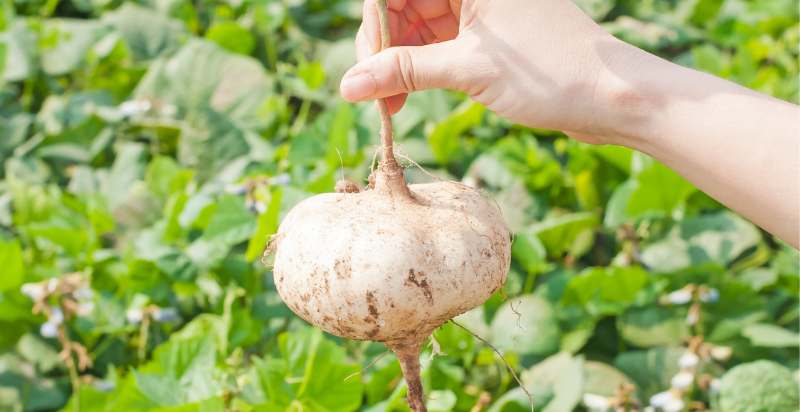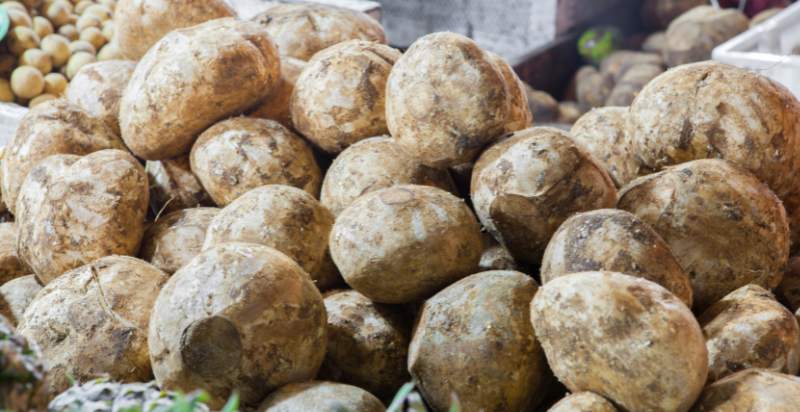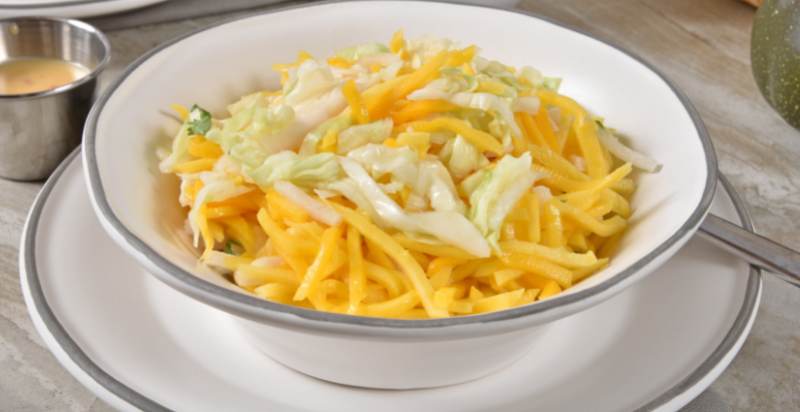Absolutely! Jicama, a delightful root vegetable from Mexico and Central America is winning hearts all around the world. With its sweet flavor and satisfying crunch, it’s a star ingredient in all kinds of dishes. Plus, it’s packed with fiber, vitamin C, and potassium, making it a nutritional powerhouse. Let’s explore the wonders of jicama together and discover fun and delicious ways to enjoy it in your diet!
About Jicama Plant:
Jicama is a type of root vegetable that belongs to the bean family. It is native to Mexico and other parts of Central America but is now widely grown in Asian countries such as China, Japan, and Thailand. Jicama has an unusual flavor—sweet with a slight tanginess—and a crunchy texture. It is usually eaten raw, sliced, or cubed and added to salads, salsas, and other dishes.

History and Origin of Jicama Plant:
Jicama is native to Mexico and other parts of Central America, but it has been cultivated in Asia since around the 16th century. It is believed that it was first brought to Europe by Spanish explorers in the late 1500s. Jicama spread worldwide during subsequent years, becoming popular in Latin America, Caribbean countries, and parts of the United States.
Types of Jicama Plants:
There are several varieties of jicama, but the most common is Pachyrhizus erosus. This variety has a long, round shape and light brown skin that is usually peeled away before eating. Other types include:
- Pachyrhizus tuberosus has a sweet flavor and white flesh.
- Pachyrhizus ahipa has an oval shape and yellow skin.
- Pachyrhizus japonicus, which has pinkish-red skins.
Nutrition Facts and Health Benefits of Jicama:
Jicama is a very nutritious vegetable. It is low in calories but high in dietary fiber, vitamin C, and potassium. Here are some of the other key nutrients present in jicama:
- Vitamin B6 – helps with metabolism, immunity, and brain health
- Calcium – important for bone strength and overall health
- Magnesium – helps regulate blood pressure and muscle contraction
- Iron – important for the production of red blood cells
In addition to its nutritional value, jicama has some potential health benefits. These include:
- Improving digestion – Jicama is rich in dietary fiber, which helps keep your digestive system running smoothly.
- Lowering cholesterol – The high fiber content of jicama may help to reduce bad cholesterol levels.
- Supporting weight loss – With its low calorie and high fiber content, jicama can be a great addition to a healthy weight loss plan.
- Boosting immunity – The vitamin C content of jicama may help to boost your immune system and protect against infection.
Plantation of Jicama:
Jicama is a root vegetable native to Mexico and Central America. It is crunchy and sweet, with a slightly nutty flavor. In the United States, it is becoming increasingly popular in salads and stir-fries. Growing jicama at home is easy and rewarding. Here’s how to start.
Planting Jicama:
Jicama needs plenty of suns and well-drained soil, so it’s best to plant in a sunny spot. Choose an area that receives at least six hours of direct sunlight daily. You can enhance the soil by adding aged compost or aged manure before you plant.
To plant jicama, start with seeds or root cuttings from an existing jicama plant. The seeds should be soaked overnight and planted ½ inch deep into moistened soil, about 18 inches apart. For root cuttings, use pieces about four inches long; these should be planted 2-3 inches deep in the soil with the pointed end up. Water lightly after planting and keep the soil moist but not soggy.
Growing Jicama:
Once planted, it will take jicama anywhere from 60 to 90 days to reach maturity, depending on the variety. Water your plants regularly – one to two inches of water a week is ideal. Make sure to water deeply and evenly so that the top 12 inches of soil are consistently moist. If you live in a hot climate, mulch your plants with straw or other organic material; this will help retain moisture and reduce weeds.
Jicama does not require any fertilizer, but if your plants are not producing fruits, you can supplement their diet with an all-purpose fertilizer when they’re about 6 weeks old.
Harvesting Jicama:
When your jicama plants reach maturity, it’s time to harvest. Cut off the stem with a sharp knife and pull the root by hand. You can store jicama for up to one month in a cool, dry place. Jicama can also be frozen for extended storage – wash, peel, and cut into slices before freezing. Enjoy!
That’s all you need to know about how to plant jicama! You can enjoy this crunchy, sweet vegetable right from your garden with just a little effort.
Plant Care for Jicama:
Once you’ve harvested your jicama, there are a few things you can do to keep them healthy and prevent disease.
To start with, make sure to remove any diseased or damaged roots from the plant before storing them. This will help prevent the spread of diseases and make them last longer. Additionally, store your jicama at temperatures between 40°F and 50°F for best results. Keep them out of direct sunlight and in a well-ventilated area; this will help keep them fresh for longer.
When growing jicama, it’s important to choose varieties that are disease resistant, so you don’t have to battle pests or fungus issues later on. Additionally, rotate your crops to avoid over-exposure to certain soil pathogens. Finally, avoid overhead irrigation, as it can spread disease from plant to plant and make the jicama more susceptible to pests.
With simple care tips, you can enjoy growing and harvesting this delicious root vegetable for years to come!
Preventions from Pests and Diseases:
Growing and harvesting jicama can be rewarding, but you may also encounter pests or diseases. To prevent these from affecting your crops, consider using natural pest control methods such as companion planting or traps. Additionally, ensuring your soil is well drained will help reduce the risk of root rot. Finally, avoid overhead irrigation to keep the disease from spreading from plant to plant.
If you find that pests or diseases have affected your plants, it’s important to act quickly to minimize the damage. Consider removing any damaged parts of the plant and treating them with an appropriate pesticide or fungicide before they spread further.
With a few simple preventative steps and early intervention, you can ensure that your jicama harvest is successful and pest-free.
How to Harvest Jicama?
Harvesting jicama is easy and rewarding. You can harvest when the tuber reaches 3 inches or more in diameter, typically around 8-10 months after planting. To do this, use a garden fork or shovel to loosen the soil around the plant and carefully lift the tuber out of the ground.
Once you’ve harvested the jicama, it can be stored in a cool, dark place for up to two months. It’s best to use soon after harvest since its flavor and texture are at their peak when fresh. Enjoy this crunchy root vegetable as part of your favorite dishes or roasted or boiled with butter and a few spices – either way, you won’t regret adding it to your garden!
And finally, remember to save some of the seeds from each tuber for replanting next year so you can enjoy another delicious crop of jicama!
Additional Tips:
When growing jicama, consider using a high-quality compost rich in nitrogen and phosphorus for optimal results. Additionally, ensure regularly watering your plants to keep them from wilting; if the soil gets too dry, it will affect their growth. Finally, rotate your crops every few years to reduce the risk of disease or pests attacking your jicama crop.
Growing jicama isn’t difficult, but it requires patience and attention. With these tips and tricks, you should succeed with this delicious root vegetable in no time.
Ways to Store Homegrown Jicama:
Jicama should be stored in a cool, dry place with plenty of air circulation. The whole jicama can be kept for weeks at room temperature, as long as it is out of direct sunlight and away from heat sources. It’s best to keep the jicama in a bag or container with holes for air circulation.
Refrigerated jicama will last longer (up to two months) but tends to lose some flavor and crunchiness. If you’ve already cut into the jicama, store it wrapped tightly in plastic wrap or an airtight container in the refrigerator. Cooked jicama dishes will last approximately four days when properly refrigerated.

How to Use Jicama?
Jicama is an incredibly versatile vegetable. It can be eaten raw or cooked in a variety of different ways. Here are some ideas for how to use jicama:
- Slice it and eat raw – Jicama slices make a great snack plain but can also be tossed with a vinaigrette or your favorite seasoning blend for additional flavor.
- Add to salads – Shredded jicama adds crunchy texture and subtle sweetness when added to green salads or fruit salads.
- Roast it – Cut into cubes, sprinkle with oil and your favorite seasonings, then roast on a baking sheet at 375F until golden brown and crispy (about 20-25 minutes).
- Blend into hummus – Roast jicama cubes and chickpeas, then blend in a food processor with tahini, garlic, lemon juice, and other ingredients of your choice for a delicious twist on classic hummus.
- Fry it – Cut into thin slices or sticks and fry in hot oil until golden brown. Serve with your favorite dipping sauce.
- Make chips – Thinly slice jicama, toss with olive oil and seasonings of your choice, then bake at 375F for about 20-25 minutes or until crisp. Enjoy as a snack or sprinkle over salads or soups for added crunch.
- Pickle it – Cut jicama into slices, then pickle in a mixture of vinegar, sugar, and spices. Enjoy as a side dish or condiment.
No matter how you use it, jicama is sure to add a unique flavor and texture to your meals! Enjoy experimenting with this delicious vegetable!

Potential Risks From Jicama:
Though jicama is an incredibly nutritious root vegetable, it does contain some potential risks.
- Allergies – People allergic to foods like apples and carrots may also develop a sensitivity to jicama. Symptoms of a jicama allergy can range from skin rashes to more severe reactions such as nausea or difficulty breathing.
- Oxalates – Jicama contains oxalates, which, in high amounts, can cause kidney stones when consumed in excess. Those with pre-existing conditions such as gout or kidney stones should speak with their healthcare provider before consuming Jicama regularly.
- Pesticides—Commercial jicama crops may be treated with pesticides, so it’s important to only consume organic jicama whenever possible.
Overall, jicama is a nutritious and delicious addition to any diet! Proper storage techniques and safe preparation methods allow you to enjoy this unique root vegetable without any risks.
Conclusion:
Jicama is an incredibly versatile and nutritious vegetable that can add unique flavor and texture to any dish. With patience and attention, you can easily incorporate this tasty root into your regular meal plan. Depending on its use, be sure to store jicama in a cool, dry place or the refrigerator. Additionally, potential risks from jicama, such as allergies, oxalates, and pesticides, should be considered when purchasing commercial crops. Enjoy experimenting with this delicious vegetable!
Happy cooking!
- Everything You Wanted to Know About Red Tamarillos - June 2, 2025
- A Guide to Tulips: Everything You Need to Know & More… - June 2, 2025
- Guanabana: Description, Flavor, Benefits, And Uses - May 27, 2025

5 thoughts on “What is Jicama? How to Plant, Grow, and Harvest Jicama Root ”
Comments are closed.